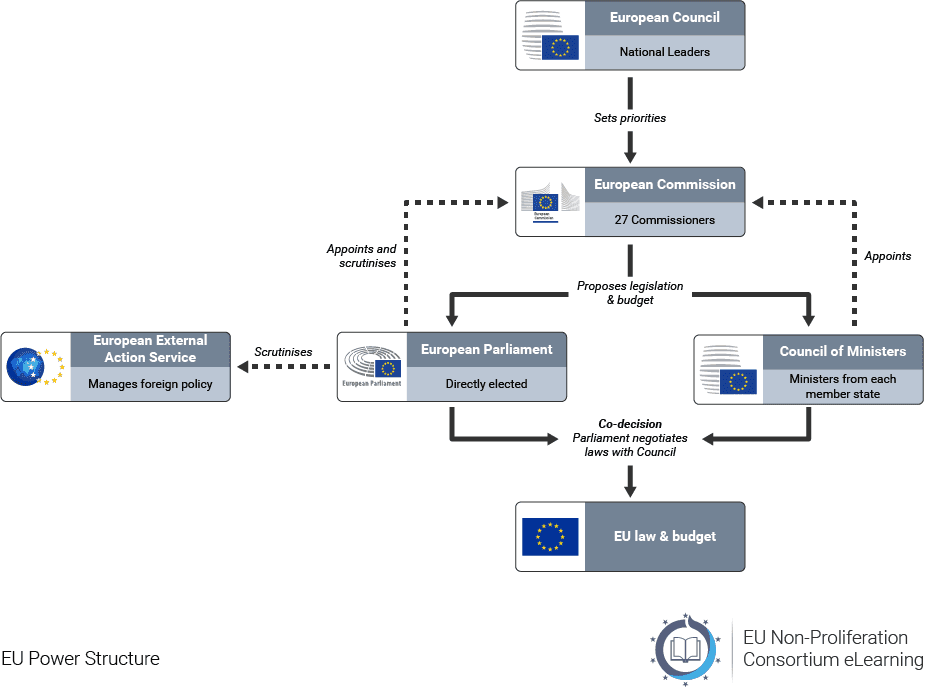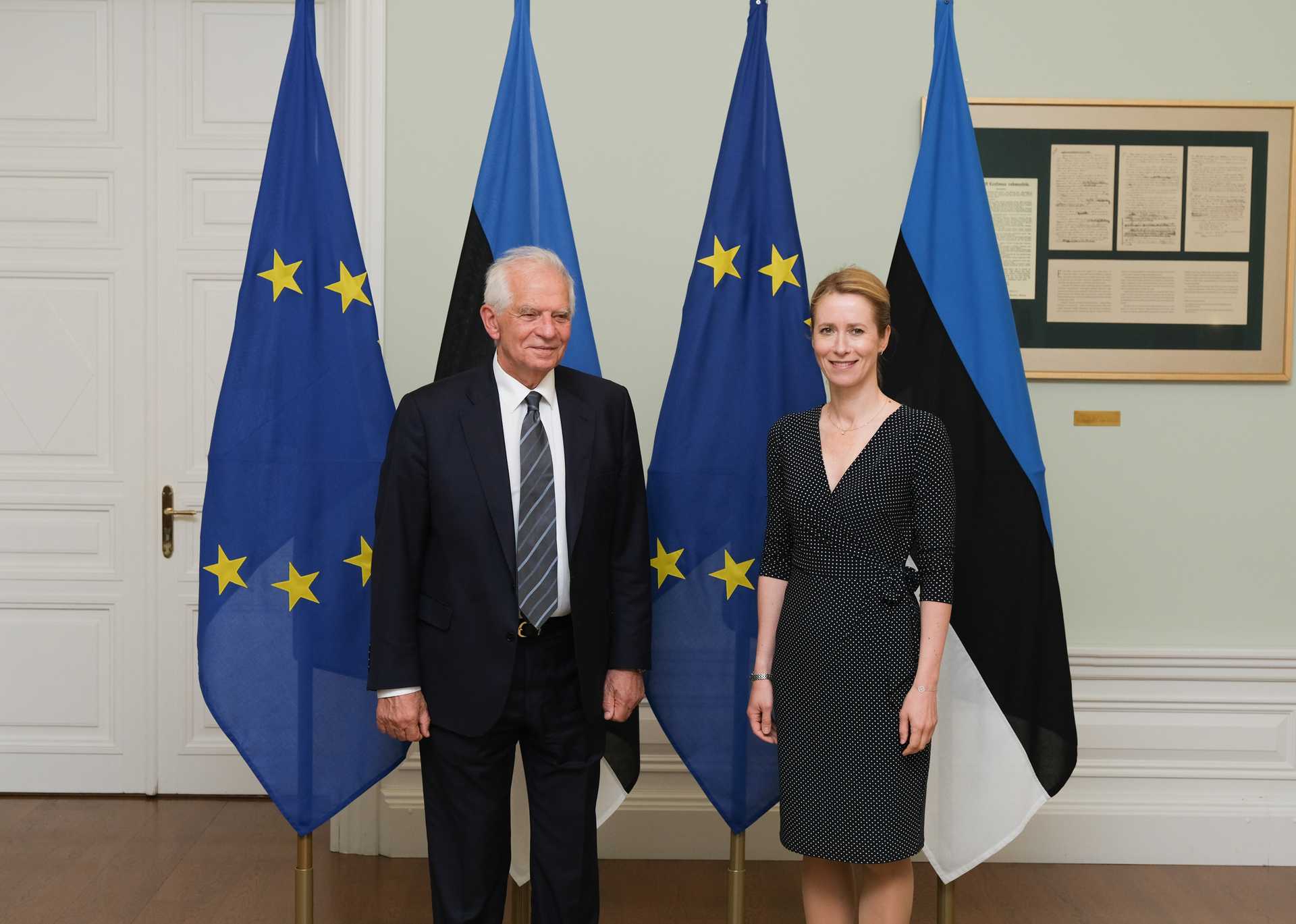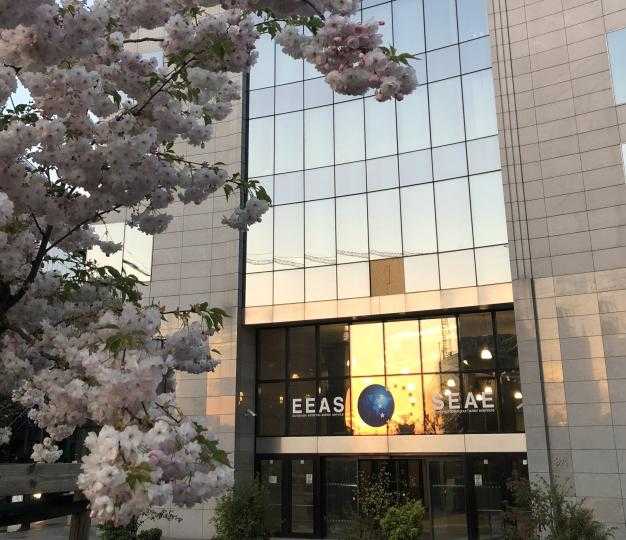The EU is a highly complex entity in terms of its institutional structure, and this is also reflected in how it conducts its external relations. In order to understand its competences and responsibilities in the area of non-proliferation and disarmament, it is first necessary to look at the general structure and interplay of the various EU institutions. Readers who are familiar with the institutions can skip this section. For the rest of you, the institutional structure of the EU, its development over time and its relevance for the issue at hand will now be briefly outlined.
Competences and institutions
As a treaty-based international organisation, the EU can only act in those areas in which it has been empowered by its member states. , the predecessor organisation of the EU founded in 1957, was granted some external competences, including the power to establish cooperation and aid programmes with third countries and entities. These programmes, which included technical assistance, were designed and implemented by the . Because they are funded from the organisation’s own budget, which remains separate from the member states’ budgets, these programmes could be administered largely independently from European capitals. In addition to the Commission, which plays a leading role, two other institutions are involved: the Council of Ministers, whose role is to green-light programmes proposed by the Commission, and the , whose agreement is required for the passing of legislation and the adoption of the general budget. Concurrently to the creation of the EEC in 1957, another organisation with identical membership was set up: a European Community for Atomic Energy (EURATOM), which dealt with peaceful uses of this energy source. It’s the functions of EURATOM largely remained internal to the EU, however.
In focus: EU Institutions and Power Structure (by Lina Grip, 2017)
EURATOM
The European Atomic Energy Community, EURATOM in short, is the oldest still existing
European institution whose tasks touch upon non-proliferation. Through EURATOM, the EU
operates an effective regional nuclear safeguards system.
Established in 1957 with the purpose of fostering co-operation in the civilian nuclear energy
field, many provisions of the EURATOM treaty cover activities and institutions that contribute
to nuclear non-proliferation.
EURATOM was for example tasked with operating an inspection regime for the civilian fuel
cycles of its members in order to prevent the diversion of fissile materials. Besides such
safeguards, the EURATOM treaty also contains an advanced export controls system.
The European Council
The European Council comprises the Heads of States or Governments of all EU Member
States, the European Council President and the President of the European Commission. The
High Representative of the Union for Foreign Affairs and Security Policy takes part in European
Council meetings when foreign affairs issues are discussed.
While the European Council has no formal legislative power, it sets the strategic direction of
the EU, including on the Common Foreign and Security Policy. The European Council meets at
least 4 times per year, and conclusions are adopted during each European Council meeting.
The European Council endorsed the as well as the two non-
proliferation strategies. We will talk about them in the next chapter.
The Council of the European Union
The , sometimes referred to as the Council of Ministers, represents the governments of the individual member states in the bicameral EU legislature. The representatives from the Member States’ Ministries for Foreign Affairs meet every month in working groups. The most important working groups for non-proliferation matters are: The Working Party on Non-Proliferation (CONOP), the Working Party on Global Disarmament and Arms Control (CODUN), and COARM—the Working Party on Conventional Weapons’ Export Control. There is also a working group on dual-use export controls (WPDU). EEAS staff chairs the working groups. The Council of the EU adopts the EU’s Council Decisions related to non-proliferation, arms control and disarmament. The majority of these allocate funding from the budget covering all activities under the EU CFSP, in order to support international organizations in their work on non-proliferation, arms control and disarmament. The Council of the EU has also agreed on various sanctions against nuclear programmes in Iran and North Korea, and many arms embargoes targeting specific states or non-state actors.
The European Commission
The European Commission is responsible for drawing up legislative proposals that it forwards to the Council and the European Parliament. It is also responsible for managing and carrying out the budget and implementing the policies and programmes adopted by the Council and the European Parliament. The Commission is increasingly active in various non-proliferation related matters. It is, for example, a very important actor in drafting and implementing specific programmes on CBRN risk mitigation. The Commission is responsible for producing Annual Work Programmes for addressing CBRN threats, and it extensively funds research on CBRN risk mitigation. The Commission’s different directorate-generals have a direct role in managing non-proliferation assistance and research inside and outside the EU. Under the authority of the High Representative, in the position’s capacity as vice-president of the Commission, the Commission is also responsible for the financial implementation of the CFSP budget and the Instrument contributing to Stability and Peace.
The European External Action Service
The is the EU’s diplomatic service under the
authority of the High Representative. It assists the High Representative in fulfilling the
position’s mandate to conduct the CFSP of the European Union and it is responsible for the
preparation and implementation of decisions adopted by the Council regarding CFSP
(including those on non-proliferation) and for supporting the Commission in the preparation of
decisions regarding the financial instruments.
EEAS staff chairs the Council working groups on non-proliferation and disarmament, CONOP,
CODUN, COARM etc. A very important aspect of the EEAS is the EU delegations around the
world. The permanent representations of the EU to international organizations in Geneva and
Vienna have become the representative of the EU to Geneva- and Vienna-based international
organizations, including the IAEA.
The European Parliament
The European Parliament has political oversight, budgetary authority and legislative capacities related to aspects of non-proliferation – especially those which fall under internal security in the EU, such as energy policy. It can advise on CFSP issues, but does not have any legislative powers on foreign and security policy. The European Parliament has in the past been active in adopting resolutions in support of non-proliferation and disarmament. Although these resolutions are not binding on the Member States, they are of symbolic value. Inter-parliamentarian delegations between the European Parliament and the national parliaments outside of the EU offer opportunities for raising political matters, including that of non-proliferation, with parliaments around the world. The European Parliament has for example long engaged in dialogue with the Iranian Parliament.

- 1957
Treaty of Rome
Founding of the European Economic Community (EEC)
- 1992
Maastricht Treaty
Founding of the European Union (EU) and launch of the Common Foreign and Security Policy (CFSP)
- 2007
Treaty of Lisbon
Establishment of the European External Action Service (EEAS)
The role of the institutions within the non-proliferation and disarmament domain
Within this complex institutional set-up, EU activities in the non-proliferation and disarmament domain emanate from two different frameworks: the strand of technical assistance for third parties is part of an integrated policy with the participation of all three governing institutions of the EU, while the political dimension of non-proliferation and disarmament policy is framed by the Council of Ministers in the intergovernmental framework of the CFSP. Thus, the role of each of the main institutions can be summarised as follows:
| EU Institution | Technical and Assistance Strand | Political Strand |
|---|---|---|
| Council of Ministers | - Green-lighting of Commission initiatives | - Decides (almost) single-handedly - Hampered by the unanimity requirement |
| European Commission | - Leadership/main responsibility | - Contributes to planning |
| European Parliament | - Budgetary powers allow it to influence foreign policy - Its agreement is required for the passing of legislation | - Limited formal power offset with activism drawing attention to foreign policy issues |
| European External Action Service | - Collaborates with the Commission in planning actions | - Programming and execution of policies in dedicated unit |
Table 1: Roles of EU institutions in the non-proliferation and disarmament domain
Source: Own elaboration
Footnotes
-
Degrand-Guillaud 2009 ↩

